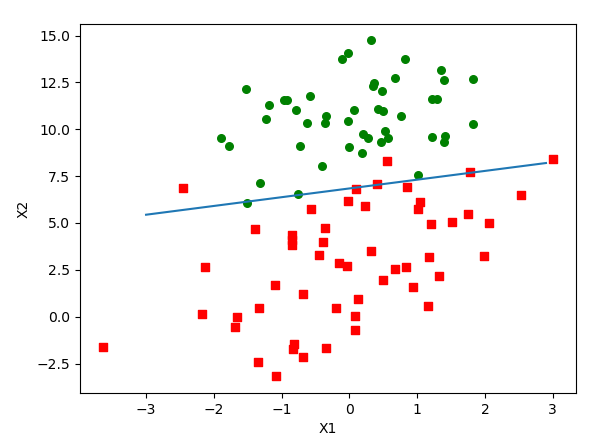Logistic回归
- 说明:本章节所有代码使用版本为Python3
优点:计算代价不高,易于理解和实现
缺点:容易欠拟合,分类精度可能不高
适用数据类型:数值型和标称型数据
??这是最优化算法。主要思想是:根据现有的数据对分类边界线建立回归公式,以此进行分类。“ 回归 ”一词源于最佳拟合,表示要找到最佳拟合参数集。训练分类器识的做法就是寻找最佳拟合参数。
Logistic回归的一般过程
- 收集数据:采用任意方法收集数据
- 准备数据:由于需要进行距离计算,因此要求数据类型为数值型。另外,结构化数据格式则最佳
- 分析数据:采用任意方法对数据进行分析
- 训练算法:计算不同独立特征的条件概率
- 测试算法:一旦训练步骤完成,分类将会很快
- 使用算法:首先需要输入一些数据,并将其转化成对应的结构化数值;接着,基于训练好的的回归系数就可以对这些数值进行简单的回归计算,判定他们属于哪个类别;之后就可以在输出的类别上做出一些其他的分析工作。
基于Logistic回归和Sigmoid函数的分类
??我们想要的函数,能接受所有的输入然后预测出类别。Sigmoid函数具有输出0或1的这种性质,而且在数学上容易处理。因此为了实现Logistic回归分类器,我们可以在每一个特征上都乘以一个回归系统,然后将所有的结果值相加,将这个总和代入Sigmoid函数中,进而得到一个范围在0~1之间的数值。Sigmoid函数定义:
σ ( z ) = 1 1 + e ? z \sigma(z)=\dfrac{1}{1+e^{-z}} σ(z)=1+e?z1?
任何大于0.5的数据被分入1类,小于0.5的数据被归入0类。所以Logistic回归也可以看成是一种概率估计。
基于最优化方法的最佳回归系数确定
??Sigmoid函数的输入记为z,公式为:
z = w 0 x 0 + w 1 x 1 + w 2 x 2 + . . . + w n x n z=w_0x_0+w_1x_1+w_2x_2+...+w_nx_n z=w0?x0?+w1?x1?+w2?x2?+...+wn?xn?
上述公式可简化为 z = W T x z=W^Tx z=WTx,它表示数值向量对应元素相乘然后全部相加起来即得到 z z z值。其中的向量 x x x是分类器的输入数据,向量 w w w是要求的最佳参数(系数),使分类器尽可能的精确。
梯度上升法
??思想:要找到某函数的最大值,最好的方法是沿着该函数的梯度方向探寻。函数 f ( x , y ) f(x,y) f(x,y)的表示:
? f ( x , y ) = ( ? f ( x , y ) ? x ? f ( x , y ) ? y ) \nabla f(x,y)= \begin{pmatrix} \dfrac{\partial f(x,y)}{\partial x} \\ \dfrac{\partial f(x,y)}{\partial y}\end{pmatrix} ?f(x,y)=?????x?f(x,y)??y?f(x,y)??????
要记住这些符号的含义:这个梯度意味着要沿
x
x
x的方向移动
?
f
(
x
,
y
)
?
x
\dfrac{\partial f(x,y)}{\partial x}
?x?f(x,y)?,沿
y
y
y的方向移动
?
f
(
x
,
y
)
?
y
\dfrac{\partial f(x,y)}{\partial y}
?y?f(x,y)?。其中,函数
f
(
x
,
y
)
f(x,y)
f(x,y)必须要在待计算的点上有定义并且可微。
??梯度算子总是指向函数值增长最快的方向。这里说的是移动方向,而没有提到移动量的大小。该量值称为步长,记作
a
a
a。用向量来表示梯度上升算法:
w : = w + a ? w f ( w ) w:=w+a\nabla_w f(w) w:=w+a?w?f(w)
??该公式将一直被迭代执行,直到达到某一停止条件为止。
??我们最经常听到梯度下降算法,它与梯度上升算法是一样的,只是公式中加法变成减法。因此,公式为:
w : = w ? a ? w f ( w ) w:=w-a\nabla_w f(w) w:=w?a?w?f(w)
??梯度上升算法用来求函数的最大值,而梯度下降算法用来求函数的最小值。
训练算法:使用梯度上升找到最佳参数
??通过梯度上升找到最佳参数,也就是拟合出Logistic回归模型的最佳参数。
分析数据:画出决策边界
??从上面已经解出了一组回归系数,他确定了不同类别数据之间的分割线。
训练算法:随机梯度上升
??梯度上升算法在每次更新回归系数的时候需要遍历整个数据集,该方法在处理100个左右的数据的时候还可以,但若有数十亿样本和成千上万的特征,该方法复杂度就太高了,一种改进的方法是一次仅使用一个样本点来更新回归系数,该方法称为随机梯度上升算法。由于可以在新样本到来时对分类器进行增量式更新,因而随机梯度上升算法是一个在线学习算法。
5、完整示例代码
from numpy import mat, shape, ones
import numpy as np
import matplotlib.pyplot as plt
from numpy.core.records import array
# 加载数据集
def loadDataSet():
dataMat = []
# 数据
labelMat = []
# 数据的标签
fr = open('testSet.txt')
for line in fr.readlines():
lineArr = line.strip().split()
# strip()将每一行数据按照换行符来分割,split()按照\t来切割
dataMat.append([1.0, float(lineArr[0]), float(lineArr[1])])
# 向dataMat中追加数据,分别是1.0,读取到的第一列数据和第二列数据
# lineArr[0]与lineArr[1]是每一组数据的两个特征
labelMat.append(int(lineArr[2]))
# 将testSet.txt文件中的最后一列数据添加到labelMat中
return dataMat, labelMat
# sigmoid函数的计算方式
def sigmoid(inX):
return 1.0 / (1.0 + np.exp(-inX))
# 计算方法:1/(1+e^(-z))
# 梯度上升算法
def gradAscent(dataMatIn, classLabels):
dataMatrix = mat(dataMatIn)
# mat()用来创建矩阵,将dataMatIn数组转化成矩阵100*3
lableMat = mat(classLabels).transpose()
# 将classLabels数组转化成二维的矩阵,此处为一个行向量,.transpose()将其转化成列向量
m, n = shape(dataMatIn)
# shape() 获取dataMatIn的行数与列数100*3
alpha = 0.001
# 学习率
maxCycles = 500
# 迭代次数
weights = ones((n, 1))
# 创建一个列向量3*1
for k in range(maxCycles):
h = sigmoid(dataMatrix*weights)
# h是一个列向量,因为weights就是一个列向量,这里的dataMatrix是100*3,weights是3*1
# 所以最终得到的是100*1的数据(列向量)传给sigmoid,相应的sigmoid返回也是列向量
error = (lableMat - h)
# lableMat与h之间的差值是误差
weights = weights + alpha * dataMatrix.transpose() * error
# 参考https://blog.csdn.net/kaka19880812/article/details/46993917
# 根据w:=w+af(w)来计算的,更新参数数值
return weights
# 画出数据集与Logistics回归最佳拟合直线的函数
def plotBestFit(weights):
dataMat, labelMat = loadDataSet()
# 加载数据集
dataArr = np.array(dataMat)
# 将数据集变成数组,此处为100*3的数组
n = shape(dataArr)[0]
# n为数组的行数
xcord1 = []
ycord1 = []
xcord2 = []
ycord2 = []
for i in range(n):
if int(labelMat[i]) == 1:
xcord1.append(dataArr[i, 1])
# 标签为 1 的数据的第一个特征追加到xcord1
ycord1.append(dataArr[i, 2])
# 标签为 1 的数据的第二个特征追加到ycord1
else:
xcord2.append(dataArr[i, 1])
# 标签为 0 的数据的第一个特征追加到xcord2
ycord2.append(dataArr[i, 2])
# 标签为 0 的数据的第二个特征追加到ycord2
fig = plt.figure()
# 新建figure对象
ax = fig.add_subplot(111)
# 新建子图1,子图格式1行1列第一个图
ax.scatter(xcord1, ycord1, s=30, c='red', marker='s')
# scatter前两个参数(x,y)设置点的位置,第三个参数设置点的大小,第四个点设置点的颜色
ax.scatter(xcord2, ycord2, s=30, c='green')
x = np.arange(-3.0, 3.0, 0.1)
# 设置 x 轴的取值范围,并设步长为0.1
y = (-weights[0]-weights[1]*x)/weights[2]
# 最佳拟合直线
ax.plot(x, y)
plt.xlabel('X1')
plt.ylabel('X2')
# x,y的标题
plt.show()
# 随机梯度上升算法
def stocGradAscent0(dataMatrix, classLabels):
m, n = shape(dataMatrix)
# 获取数据集的行列数m,n
dataMatrix = np.array(dataMatrix)
# 这一行代码是为了解决:TypeError: can't multiply sequence by non-int of type 'float'
# 笔者在实现的时候,一直报这个错误,差一些以文章还是没有答案,最后在一篇博文中找到了解决办法
# 原文是:https://blog.csdn.net/qq_43149373/article/details/89790153
alpha = 0.01
# 学习率
weights = np.ones(n)
# 创建一个 1行,n列的矩阵
for i in range(m):
h = sigmoid(sum(dataMatrix[i]*weights))
# 与梯度上升算法不同,随机梯度上升算法h与error都是数值
# sum(dataMatrix[i]*weights)将所有的特征,都转化成了一个数值
error = classLabels[i]-h
# 真正的标签值与预测的误差
weights = weights+alpha*error*dataMatrix[i]
# 更新回归系数
return weights
# 改进随机梯度上升算法
def stocGradAscent1(dataMatrix, classLabels,numIter=150):
m, n = shape(dataMatrix)
# 获取数据集的行列数m,n
dataMatrix = np.array(dataMatrix)
# 这一行代码是为了解决:TypeError: can't multiply sequence by non-int of type 'float'
# 笔者在实现的时候,一直报这个错误,查了一些以文章还是没有答案,最后在一篇博文中找到了解决办法
# 原文是:https://blog.csdn.net/qq_43149373/article/details/89790153
weights = np.ones(n)
# 创建一个 1行,n列的矩阵
for j in range(numIter):
dataIndex=list(range(m))
# 笔者在实现代码的时候发现dataIndex=range(m)报错:TypeError: 'range' object doesn't support item deletion
# 根据上一个的教训,直接变成list,可以实现删除,则强转为list类型
for i in range(m):
alpha = 4/(1.0+j+i)+0.01
# 学习率,每次迭代都会进行调整
randIndex=int(np.random.uniform(0,len(dataIndex)))
# 随机选取更新,从一个均匀分布[low,high)中随机采样,注意定义域是左闭右开,即包含low,不包含high
h = sigmoid(sum(dataMatrix[randIndex]*weights))
# 与梯度上升算法不同,改进的随机梯度上升算法h与error都是数值
# sum(dataMatrix[randIndex]*weights)将所有的特征,都转化成了一个数值
error = classLabels[randIndex]-h
# 真正的标签值与预测的误差
weights = weights+alpha*error*dataMatrix[randIndex]
# 更新回归系数
del(dataIndex[randIndex])
# 选用过后的数据要删除,避免重复使用
return weights
dataMatIn, classLabels = loadDataSet()
weights = stocGradAscent1(dataMatIn, classLabels)
# 改进之后的梯度上升算法
weights = stocGradAscent0(dataMatIn, classLabels)
# 改进之前的梯度上升算法
plotBestFit(weights)
# plotBestFit(weights.getA())
# getA()或mat.A ,matrix矩阵名.A 代表将矩阵转化为array数组类型
# 这个是梯度上升算法使用时调用的
 梯
度
上
升
算
法
结
果
梯度上升算法结果
梯度上升算法结果
梯
度
上
升
算
法
结
果
梯度上升算法结果
梯度上升算法结果
 随
机
梯
度
上
升
算
法
结
果
随机梯度上升算法结果
随机梯度上升算法结果
随
机
梯
度
上
升
算
法
结
果
随机梯度上升算法结果
随机梯度上升算法结果
改 进 随 机 梯 度 上 升 算 法 结 果 改进随机梯度上升算法结果 改进随机梯度上升算法结果
??从结果上看,梯度上升算法比改进前的梯度上升算法要好。因为改进前的梯度上升算法分类器错分了近一半的样本,但是直接看结果是不公平的。梯度上升算法在整个数据集上迭代了500次,才将结果收敛达到了稳定值,而改进前的梯度上升算法在整个数据集上迭代了200次达到了最终的效果。
??改进后的程序,通过随机选取样本来更新回归系数,这种方法将减少周期性的波动,而且增加了一个迭代次数作为第三个参数。
示例从疝气病症预测病马的死亡率
使用Logistic回归估计马疝病的死亡率
- 收集数据:给定数据文件
- 准备数据:用python解析文本文件并填充缺失值
- 分析数据:可视化并观察数据
- 训练算法:使用优化算法,找到最佳的系数
- 测试算法:为了量化回归的效果,需要观察错误率。根据错误率决定是否回退到训练阶段,通过改变迭代的次数与步长等参数来得到更好的回归系数
- 使用算法:实现一个简单的命令行程序来收集马的症状并输出预测的结果
1、准备数据:处理数据中的缺失值
??解决缺失数据的一些可选办法:
- 使用可用特征的均值来填补缺失值
- 使用特殊值来填补缺失值,如-1
- 忽略有缺失值的样本
- 使用相似样本的均值添补缺失值
- 使用另外的机器学习算法预测缺失值
??在预处理阶段需要做的事:
- 所有的缺失值必须有一个实数来替换,因为numpy数据类型不允许包含缺失值
- 若在测试数据中发现了一条数据类别的标签已经有缺失,则最简单的方式是直接丢弃该数据
2、测试算法:用Logistic回归进行分类
??将数据上的每一个特征向量乘以最优化方法得来的回归系数,再将该乘积结果求和,最后输入到Sigmoid函数中即可
3、完整示例代码
import numpy as np
from numpy import *
# 以回归系数与特征向量作为输入来计算对应Sigmoid值
def classifyVector(inX,weights):
prob=sigmoid(sum(inX*weights))
# 求Sigmoid值
if prob>0.5: return 1.0
else: return 0.0
# 要是Sigmoid值大于0.5则返回 1 ,否则返回 0
# 对数据进行格式化处理,并计算错误率
def colicTset():
frTrain=open('./horseColicTraining.txt')
# 读取训练数据
frTest=open('./horseColicTest.txt')
# 读取测试数据
trainingSet=[]
trainingLabels=[]
for line in frTrain.readlines():
currLine=line.strip().split('\t')
# strip()将每一行数据按照换行符来分割,split()按照\t来切割,形成数组
lineArr=[]
for i in range(21):
lineArr.append(float(currLine[i]))
# 获取前20列的数据,保存到lineArr中,这是训练数据
trainingSet.append(lineArr)
# 训练数据放到trainingSet中
trainingLabels.append(float(currLine[21]))
# 最后一列是标签,将标签数据放到trainingSet中
trainWeights=stocGradAscent1(array(trainingSet),trainingLabels,500)
# 使用改进随机梯度上升算法,迭代次数500,求回归向量系数
errorCount=0
numTestVec=0.0
for line in frTest.readlines():
numTestVec+=1.0
# 测试数据个数
currLine=line.strip().split('\t')
# strip()将每一行数据按照换行符来分割,split()按照\t来切割,形成数组
lineArr=[]
for i in range(21):
lineArr.append(float(currLine[i]))
# 获取前20列的数据,保存到lineArr中,这是当前一行数据的所有值
if int(classifyVector(array(lineArr),trainWeights))!=int(currLine[21]):
# classifyVector返回对应Sigmoid值, 0 或者 1 ,与测试属于比较,要是预测与实际不相同证明预测是错误的
errorCount+=1
errorRate=(float(errorCount)/numTestVec)
# 错误率是预测错误个数除以测试数据个数
print("The error rate of this test is %f"%errorRate)
return errorRate
# 返回错误率
def multiTest():
numTest=10
# 选用10次进行测试
errorSum=0.0
for k in range(numTest):
errorSum+=colicTset()
# 10次测试求平均值
print("After %d iterations the average error rate is: %f"%(numTest,errorSum/float(numTest)))
# sigmoid函数的计算方式
def sigmoid(inX):
# return 1.0 / (1.0 + np.exp(-inX))
# 计算方法:1/(1+e^(-z))
# 在运行的时候报错了:RuntimeWarning: overflow encountered in exp
# 网上的解释是:https://blog.csdn.net/CY_TEC/article/details/106083366
if inX>=0:
# 对sigmoid函数的优化,避免了出现极大的数据溢出
return 1.0/(1+np.exp(-inX))
else:
return np.exp(inX)/(1+np.exp(inX))
# 改进随机梯度上升算法
def stocGradAscent1(dataMatrix, classLabels,numIter=150):
m, n = shape(dataMatrix)
# 获取数据集的行列数m,n
dataMatrix = np.array(dataMatrix)
# 这一行代码是为了解决:TypeError: can't multiply sequence by non-int of type 'float'
# 笔者在实现的时候,一直报这个错误,查了一些以文章还是没有答案,最后在一篇博文中找到了解决办法
# 原文是:https://blog.csdn.net/qq_43149373/article/details/89790153
weights = np.ones(n)
# 创建一个 1行,n列的矩阵
for j in range(numIter):
dataIndex=list(range(m))
# 笔者在实现代码的时候发现dataIndex=range(m)报错:TypeError: 'range' object doesn't support item deletion
# 根据上一个的教训,直接变成list,可以实现删除,则强转为list类型
for i in range(m):
alpha = 4/(1.0+j+i)+0.01
# 学习率,每次迭代都会进行调整
randIndex=int(np.random.uniform(0,len(dataIndex)))
# 随机选取更新,从一个均匀分布[low,high)中随机采样,注意定义域是左闭右开,即包含low,不包含high
h = sigmoid(sum(dataMatrix[randIndex]*weights))
# 与梯度上升算法不同,改进的随机梯度上升算法h与error都是数值
# sum(dataMatrix[randIndex]*weights)将所有的特征,都转化成了一个数值
error = classLabels[randIndex]-h
# 真正的标签值与预测的误差
weights = weights+alpha*error*dataMatrix[randIndex]
# 更新回归系数
del(dataIndex[randIndex])
# 选用过后的数据要删除,避免重复使用
return weights
multiTest()
小结
??Logistic回归的目的是寻找一个非线性的函数Sigmoid的最佳拟合参数,求解过程可以是最优化算法来完成。在最优化算法中,最常用的是梯度上升算法,而梯度上升算法又可以简化为随机梯度上升算法。
??随机梯度上升算法与梯度上升算法效果相当,但是占用资源较少。此外随机梯度上升是一个线性算法,它可以在新数据到来时就完成参数更新,而不需要重新读取整个数据集来进行批处理运算。
??机器学习的一个重要问题就是处理缺失数据,解决的方法取决于实际应用的需求。
由于代码中horseColicTraining.txt与horseColicTest.txt文件数据较多,请读者自行查找数据
